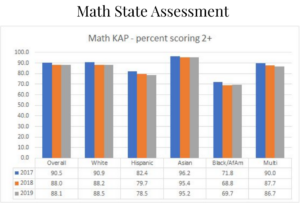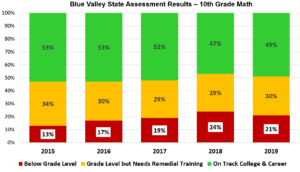Former President Bill Clinton’s attempt to refute that he ‘is’ in a relationship with an intern may be the most famous example of paltering – intentionally misleading someone with careful wording that may technically be true.
Paltering is a way of life for many in government who constantly deceive taxpayers, parents, you name it, to benefit their own interests. An example was recently provided at the June 14 Blue Valley school board meeting.
Director of Academic Achievement & Accountability Adam Wade told school board members that “a 2 on the state assessment exam shows basic ability with regard to skills and knowledge needed for college and career readiness.”
 While giving this explanation, Wade showed the audience slides of students scoring 2+ on the state assessment in Math and other subjects. The intended takeaway, for example, is that 88.1% of students were on track for college and career in 2019.
While giving this explanation, Wade showed the audience slides of students scoring 2+ on the state assessment in Math and other subjects. The intended takeaway, for example, is that 88.1% of students were on track for college and career in 2019.
But that’s not even close to being true. Level 2 indicates a student who is at grade level but still needs remedial training to be on track for college and career. Wade knows that Level 2 is NOT on track for college and career. Superintendent Tonya Merrigan knows it, too, but she allowed the paltering to go on unchallenged, deceiving board members and everyone watching the board meeting. You can see for yourself; his presentation begins at the 1:18:17 mark of the video.
Less than half on track for college and career
Wade’s representation of state assessment scores referenced results for all students tested in grades 3-8 and 10, and that is also deceptive. As students advance each year, the percentage of students who are on track declines precipitously. To truly understand whether education officials are preparing students for college and career, you need to look at the 10th-grade results.
 Blue Valley would have parents believe that 79% of 10th-graders are on track for college and career. (FYI, schools never show the 10th-grade results because that would raise questions, like how it is possible to have a 98% graduation rate with 21% below grade level.) But in reality, only 49% are on track (Levels 3&4); the 30% in Level 2 are at grade level but still need remedial training to be on track, and 21% are below grade level.
Blue Valley would have parents believe that 79% of 10th-graders are on track for college and career. (FYI, schools never show the 10th-grade results because that would raise questions, like how it is possible to have a 98% graduation rate with 21% below grade level.) But in reality, only 49% are on track (Levels 3&4); the 30% in Level 2 are at grade level but still need remedial training to be on track, and 21% are below grade level.
The state assessment wasn’t given in 2020 because Governor Kelly closed schools at the beginning of the COVID situation. The last five years have shown declining achievement in Blue Valley and many other districts.
High school students on track for college and career in Math dropped from 53% in 2015 to 49%, and high school students below grade level jumped from 13% to 21%. Meanwhile, paltering was the language of school board members and administrators as they patted themselves on the back for doing a great job.
The situation is even worse in many districts. Parents are not supposed to know this, but there are more high school students below grade level in Kansas than are on track for college and career. Only 25% are on track in Math, and just 28% in English Language Arts; those pitiful outcomes track with the 2020 ACT test, where only 23% of Kansas graduates were considered college-ready in English, Reading, Math, and Science.
Many education officials have a Ph.D. in paltering, and that will never change until parents understand the depth of the problem. Parents and employers must demand that legislators pass parental choice measures for students below grade level, and give kids a fighting chance.




